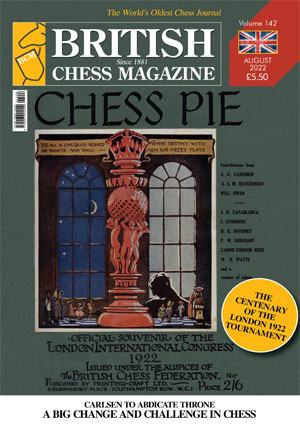
by ChessBase

9/5/2022 – The August issue of BCM is dedicated to the centenary of the great London 1922 tournament which saw the greatest players in the world take part, including Jose Raul Capablanca who appeared in public for the first time since winning the World Title. With century-old comments about the tournament and photos, and with contemporary reviews of the event and the opening theory, the August issue of BCM includes everything you need to know about the great London 1922 event.
ChessBase 16 - Mega package Edition 2022
Your key to fresh ideas, precise analyses and targeted training!
Everyone uses ChessBase, from the World Champion to the amateur next door. It is the program of choice for anyone who loves the game and wants to know more about it. Start your personal success story with ChessBase and enjoy the game even more.

Thomas Rayner Dawson (28 November 1889 – 16 December 1951) was a brilliant English chess problemist and a problem and endgames editor for BCM. Chess Pie in 1923 gave the following biography of TR Dawson:
THOMAS RAYNER DAWSON, M.Sc, A.I.C., born 1889 in Leeds, follows the bent of his famous uncle, the late James Rayner, who edited the problem section of the British Chess Magazine for many years. Dawson, learning chess at the age of 12, like Bernard was driven to problem lore by lack of opponents at the game. His first two-mover was published in 1907, but he soon found that chess, as played, would not satisfy his strong bent for every form of puzzle. In his own words, ‘appalled by the monotonous sameness of direct maters,’ Dawson took up the study of ‘Fairy Chess,’ in which composers make their own fanciful conditions of play, and found here so vast and fascinating a field that he has produced nearly 2,000 chess puzzles in the last 15 years. Dawson is a prominent Chess Editor and conducts very popular columns in the ‘Chess Amateur’ and the Italian ‘L’Alfiere di Re.’
The Oxford Companion to Chess (1996) describes him in the following words:
“English composer, pioneer of both fairy problems and retrograde analysis. His problems in these fields form the greater part of his output (about 6,500 compositions) and are better remembered than his studies and orthodox problems. For fairy problems he invented new pieces: grasshopper (1912) LEO (1912), NEUTRAL MAN (1912) NIGHT RIDER (1925), and VAO (1912); he codified new rules such as the maximummer (1913) and various kinds of series-mover; and he used unorthodox boards.”
In the period of 1919 to 1930 he wrote a column devoted to fairy problems in the Chess Amateur. He is one of the cofounders of The Problemist in 1926. From 1931 up to 1936 he was the editor of The Problemist Fairy Supplement and finally moving to The Fairy Chess Review (1936 until his passing in 1951). He was President of The British Chess Problem Society from September 1931 to 1943.
He was the problem section editor of the British Chess Magazine from 1931 to 1951. In December 1947 he left the post of endgame editor for BCM parting from the readers with the following message: “With this page I reluctantly terminate on health grounds some forty years of work in the Endings field, and my contributions to this corner of the “British Chess Magazine”. To the many readers of these pages, a Merry Christmas and steadily improving years.”
During his career he composed some 6,400 problems and 150 studies.
Away from chess, TR Dawson (who graduated chemistry) worked in the rubber industry where he rose to prominence.
BCM Endgames and Problem editor TR Dawson on the London 1922 tournament:
IMPRESSIONS AND GOSSIP OF A FIRST VISIT SPECIALLY CONTRIBUTED TO THE "C.A." – September, 1922

Never having visited a chess congress before, I went with an open mind, prepared for anything I found it. Chess congresses, I soon learned, are not really for chess, but only for chess play. There is, however, a social side of the congress which is pleasantly good—saying “How d’you do?” to folk you have exchanged letters with for years and never previously met, is rather exciting.
My day there covered the 5th round of the principal tournament and supplied a variety of incidents more or less worth mentioning. The first hour or so of play was exceedingly dull. Only the most ardent enthusiastic students of the openings can find interest, in the sound, stolid, first fifteen moves or so of these master games. The three deep serried ranks round the Capablanca board indicated, indeed, that a classic hero was more attractive than mere openings. During this period I wandered about, a disconsolate lost problemist, seeking distractions. Not being able to pursue my acquaintance with Wahltuch, Watson, and Yates beyond nods, during their serious struggle over the board, I was glad to light upon our genial problem editor and Dr. Schumer. The latter gave me some amusing reflections, for referring to my predilection for the humorous and fantastic, Dr. Schemer waved his hand toward the players with the comment: “This is serious chess, of course.” I admit the “serious,” but beg to doubt the “of course.” I idly reflected that these masters put in some four or six hours’ strenuous thought over one game—and it is strenuous alright, some of them being obviously tired out by the end of the day. But we problemists think nothing of twenty, forty, a hundred strenuous hours over one solitary problem. There are two of my retro problems cost me six years of intermittent work—at a guess, a thousand hours--to complete, and I have a score of others over which I have worked ten years, and they are still baffling me. This, “of course,” is not serious chess, I presume.
The first mild excitement of the day developed over the Marotti-Yates game. The Italian player, apparently somewhat outclassed in this tourney, made a wretched move that lost a Pawn and the exchange, and resigned forthwith. The game might have been very interesting otherwise, as it exhibited a definite strategic structure. Yates was meeting a promising attack on his K-side castled King by a vigorous counter-attack on a Q-side castled King, and the pieces being so distinctly orientated, a rare race for the first telling blow seemed due.
Somewhere about this time the thickening of the crowd round the Morrison-Euwe board indicated happenings, and the well-known, player and problemist, Mr. F. F. L. Alexander and myself were perched on chairs at the back of the crush getting occasional glimpses of the board. As no move transpired for ten minutes or more, Alexander and I immersed ourselves in a pocket board and problem lore, oblivious of crowds, game, or our own precarious elevation. The absurdity of standing on chairs to do problems, instead of sitting, occurred to me only when running over the day’s events for this paper.
However the game went on spite of us and we awoke from dreams to the following critical position (Diagram 1).
In position 1, the Canadian champion, with a Knight for a couple of Pawns, was confronted by a stiff attack on his King. The next move or two ran 1...Qg4 2.Ke1 Th2 3.Kd2 Rxf2+ 4.Kc3 Qe4 5.Rd3 f4. Half an hour later, I returned to witness the climax, in Diagram 2.
Evidently the young Dutch player would profit by a dose of problems for he played the wretched move, Rxd2, leaving the Canadian a simple mate in two and a well-deserved win.
Contemporary with the preceding events, and at the next board, two seasonal warriors, Reti and Tartakower, were fencing elegantly in the closing stages of a delicate ending (No. 3).
In the position 3, the play ran 1.Nxf4 Rd4 2.Ne6 Rxc4 3.Rd1 Bc6 4.Rd8 ¦xd8 5.Nxd8 Bd5 6.Rd3 Rc1+ 7.Kf2 Rc4 8.Rd7 Rc2+ 9.Kg1, and agreed drawn. I watched the two players compare notes while running rapidly over a dozen continuations and the endings lover will find plenty of play. Black’s extra £ side Pawn. is balanced by White’s ¤ to ¥. hence the draw.
Diagram 4 gives the Wahltuch-Maroczy game at the adjournment for tea, White to play. This complex block position resulted, in the evening, after a dozen moves so, in a draw by tacit perpetual check. Over one tense move, Marozcy meditated 37 minutes, seeking a win in vain. I luckily hit the moment, after the decision, when a ‘frogpond,’ if I may apply the irreverent Americanism to our foreign visitors, of Bogoljubow, Capablanca, Reti, Rubinstein, Vidmar, and others, dissected the position. Readers of these irresponsible notes will like to explore one alluring attack that was propounded in Diagram 4- vi., Ra7. followed by Pc5—when the fur and feathers fly. But the gem of the evening, and the only bit of chess play all day that I really enjoyed arose from another line of play, resifting in the following Pawn ending:
The ‘frogpond’ dialogue was approximately:
Wahltuch: “Could I have won this Pawn ending alter changing everything off?”
Maroczy: “Never in your life! The ending is drawn.”
Capablanca: “I’ll try 1.e5!”
Wahltuch: “Ha- Better not, take it. You must, move your King back.”
Maroczy: “Not, a bit. I can take it, 1… dxe5.”
Capablanca: “2.c5.”
Maroczy: “2… ¢f8.”
Capalalanca: “3.d6.”
Maroczy: “3…¢e8.”
Capablanca: “4.dxc7.”
Mavoczy: “4...¢d7.”
Capablanca: “5.cxb6!”
Wahltuch: “Got him, by jove.”
Maroezy: “You think it’s won, eh? But see: 5…f5”
And the frogpond chuckled, and tried something else. Of course this sparkling bit of fencing was not serious chess—it was much too pretty for that.
The other games in the round, which I have not mentioned, were all too dull to excite comment. I came away from my first day at a congress very glad that I was not a professional reporter of such doings.
T. R. DAWSON
 The above article appeared in the July 2022 issue of The British Chess Magazine, the world's oldest chess publication. It is reproduced with kind permission.
The above article appeared in the July 2022 issue of The British Chess Magazine, the world's oldest chess publication. It is reproduced with kind permission.
BCM covers the international and British chess scene. In a blend of current event coverage and thought-provoking analysis of the chess world’s most topical issues, BCM gives readers what they need to understand and enjoy the Royal Game and its wider context in society. BCM’s interviews with top players and key chess world influencers and participants (actors, businessmen, artists, politicians, top chess world administrators), detailed games analysis and historical articles provide in-depth coverage of chess events and wider chess themes.
Published monthly, each issue of The British Chess Magazine contains 64 pages packed with exclusive articles and annotations. You can buy a subscription (£55 per year, £4.58 per issue) or download a sample copy free.
Pop-up for detailed settings
We use cookies and comparable technologies to provide certain functions, to improve the user experience and to offer interest-oriented content. Depending on their intended use, cookies may be used in addition to technically required cookies, analysis cookies and marketing cookies. You can decide which cookies to use by selecting the appropriate options below. Please note that your selection may affect the functionality of the service. Further information can be found in our privacy policy.
"gossip" - Google News
September 05, 2022 at 09:04PM
https://ift.tt/jWSfrZb
T.R.Dawson: Impressions and Gossip - ChessBase
"gossip" - Google News
https://ift.tt/Zv40iIo
Shoes Man Tutorial
Pos News Update
Meme Update
Korean Entertainment News
Japan News Update











No comments:
Post a Comment